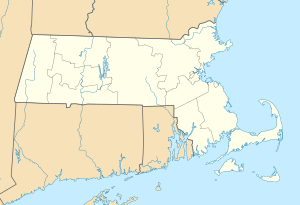USS Lionfish (SS-298)

USS Lionfish
|
|
| History | |
|---|---|
|
|
|
| Name: | Lionfish |
| Namesake: | Lionfish |
| Builder: | Cramp Shipbuilding Company, Philadelphia / Portsmouth Naval Shipyard, Kittery, Maine |
| Laid down: | 15 December 1942 |
| Launched: | 7 November 1943 |
| Sponsored by: | Mrs. Harold C. Train |
| Commissioned: | 1 November 1944 |
| Decommissioned: | 16 January 1946 |
| Recommissioned: | 31 January 1951 |
| Decommissioned: | 15 December 1953 |
| Struck: | 20 December 1971 |
| Status: | Museum ship at Battleship Cove, Fall River, Massachusetts since 30 August 1972 |
| General characteristics | |
| Class and type: | Balao-class submarine |
| Displacement: |
|
| Length: | 311 ft 6 in (94.95 m) |
| Beam: | 27 ft 3 in (8.31 m) |
| Draft: | 16 ft 10 in (5.13 m) maximum |
| Propulsion: |
|
| Speed: |
|
| Range: | 11,000 nmi (20,000 km; 13,000 mi) surfaced at 10 knots (19 km/h; 12 mph) |
| Endurance: |
|
| Test depth: | 400 ft (120 m) |
| Complement: | 10 officers, 70–71 enlisted |
| Armament: |
|
|
USS Lionfish (SS-298)
|
|
| Location | Fall River, Massachusetts |
| Coordinates | 41°42′22″N 71°09′47″W / 41.70611°N 71.16306°WCoordinates: 41°42′22″N 71°09′47″W / 41.70611°N 71.16306°W |
| Built | 1943 |
| Architectural style | Other |
| NRHP Reference # | 76002270 |
| Significant dates | |
| Added to NRHP | 30 September 1976 |
| Designated NHL | 14 January 1986 |
USS Lionfish (SS-298), a Balao-class submarine, was the only ship of the United States Navy named for the lionfish, a scorpaenid fish native to the Pacific and an invasive species found around the Caribbean. She was designated a National Historic Landmark in 1986, and is now on display at Battleship Cove in Fall River, Massachusetts.
Lionfish was laid down on 15 December 1942; launched on 7 November 1943, sponsored by Mrs. Harold C. Train; and commissioned on 1 November 1944. Her first captain was Lieutenant Commander Edward D. Spruance, son of World War II admiral Raymond Spruance.
After completing her shakedown cruise off New England, she began her first war patrol in Japanese waters on 1 April 1945. Ten days later, she avoided two torpedoes fired by a Japanese submarine. On 1 May Lionfish destroyed a Japanese schooner with her deck guns. After a rendezvous with the submarine USS Ray, she transported B-29 survivors to Saipan and then made her way to Midway Island for replenishment.
On 2 June she started her second war patrol, and on 10 July fired torpedoes at a surfaced Japanese submarine, after which Lionfish's crew heard explosions and observed smoke through their periscope (the Submarine I-162 was undamaged). She subsequently fired on two more Japanese submarines. Lionfish ended her second and last war patrol performing lifeguard duty (the rescue of downed fliers) off the coast of Japan. When World War II ended on 15 August she headed for San Francisco and was decommissioned at Mare Island Navy Yard on 16 January 1946.
...
Wikipedia

